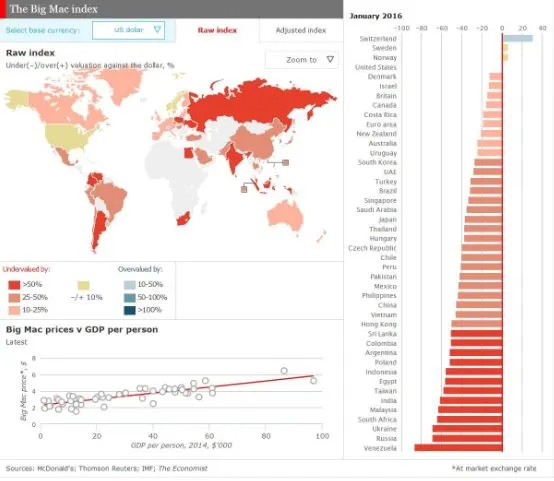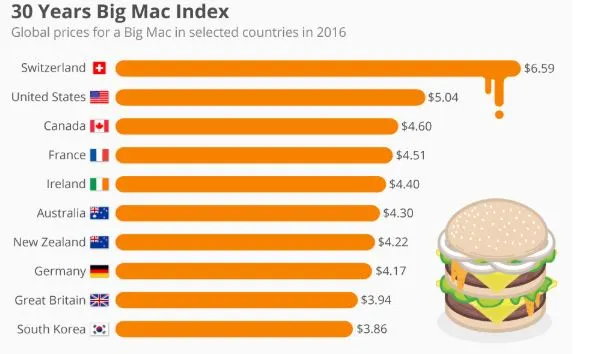The Big Mac Index, introduced by The Economist in 1986, offers a unique way to gauge the value of currencies globally. By comparing the price of a Big Mac in different countries, it provides a glimpse into purchasing power parity (PPP). In an ideal world, identical goods should cost the same in every country when expressed in a common currency.
The index helps reveal whether a currency is undervalued or overvalued relative to the U.S. dollar. While it’s not a perfect measure, it has become a popular tool for economists and currency traders alike.
The Big Mac Index is a simple concept. If a Big Mac costs significantly more in one country than another, the first country’s currency may be overvalued, while the second country’s currency could be undervalued. This provides insight into the relative strength of the U.S. dollar compared to other currencies around the world.

History and Evolution of the Big Mac Index
The Big Mac Index was first introduced as a fun idea in The Economist back in 1986. The purpose was simple: to use a familiar item like the Big Mac to gauge currency strength. Over time, it has evolved from a quirky concept into a respected tool for assessing the value of currencies. When it was first launched, the idea of comparing the price of a Big Mac across countries was a lighthearted way to introduce the concept of purchasing power parity (PPP) to the public.
Over the years, the index has been used to track the strength of the U.S. dollar, showing how its value changes in comparison to other currencies. In 1967, a Big Mac cost just 47 cents in the U.S. By 1986, the price had increased to $1.60, and today, it hovers around $4.30. The overall trend shows a gradual depreciation of the U.S. dollar, which is an interesting reflection of long-term economic changes.
How the Big Mac Index Reflects Currency Strength and Value?
The primary use of the Big Mac Index is to help determine whether a currency is overvalued or undervalued. This is possible because McDonald’s operates in almost every country around the world, selling a standardized product. The Big Mac, being nearly identical everywhere, provides a consistent product for comparison.
For example, if a Big Mac is significantly more expensive in one country than in another, it signals that the first country’s currency might be overvalued. Conversely, if a Big Mac costs less in a second country, the local currency could be undervalued. A comparison of the U.S. dollar to the euro in 2018 showed that a Big Mac in the U.S. cost $5.51, while in Germany, it cost €3.99. Converting the German price to dollars, we found the real value of the euro was 0.72 USD, suggesting that the U.S. dollar was undervalued compared to the euro.
This same principle applies to other countries and currencies. In countries where the price of a Big Mac is high, such as Switzerland or Norway, the local currency is often overvalued. On the other hand, in countries like Argentina or South Africa, the cost of a Big Mac may be much lower, signaling an undervaluation of the local currency.
What Factors Influence the Cost of the Big Mac Globally?
Several factors affect the price of a Big Mac in different countries. Currency exchange rates are just one of these factors. Local economic conditions, such as labor costs, inflation rates, and the cost of ingredients, all contribute to the final price.
Labor costs are a significant influence. In developed countries like the U.S., Switzerland, and Japan, wages are high, which raises the price of producing a Big Mac. In contrast, in countries with lower wages, such as India or Egypt, the cost of a Big Mac is much lower.
Inflation is another factor. In countries with high inflation, like Venezuela, the price of a Big Mac increases rapidly. Similarly, the cost of ingredients also varies by region. In countries where the key ingredients for a Big Mac, such as beef and lettuce, are expensive to import, the price of the burger rises. Even the cost of rent, utilities, and energy, which vary by country, can affect the final price.
Big Mac Index as a Tool for Currency Traders
Currency traders often use the Big Mac Index to make informed decisions about which currencies to trade. By comparing the prices of Big Macs in different countries, traders can identify currencies that may be undervalued or overvalued. This gives them an edge in the highly competitive forex market.
If the Big Mac Index suggests that the U.S. dollar is undervalued, traders might decide to buy U.S. dollars, anticipating that it will appreciate. Conversely, if the index shows that the U.S. dollar is overvalued, traders might opt to sell their dollars and invest in other currencies.
The Big Mac Index also helps traders spot trends. If a country’s Big Mac prices are consistently lower than those in the U.S., it might indicate that the local currency is undervalued. Traders could then take advantage of this by investing in that currency, expecting it to appreciate in the future.
Why Some Currencies Are More Expensive Than Others (Switzerland vs Egypt)

The Big Mac Index clearly shows the disparity between developed and developing countries. For example, the cost of a Big Mac in Switzerland is much higher than in Egypt or India. This is because labor costs and the cost of living are much higher in Switzerland than in countries with lower wages.
In Switzerland, a Big Mac may cost around $7, reflecting the strong Swiss franc and high wages in the country. In contrast, in Egypt, a Big Mac might cost just $2.50. This price reflects the lower wages and the undervaluation of the Egyptian pound.
This difference in pricing is not just due to wages but also to broader economic conditions. Developed countries like Switzerland have strong currencies and higher costs of living, pushing up the price of a Big Mac. Meanwhile, in countries with weaker economies, the Big Mac is often cheaper due to the lower cost of living and weaker currencies.
How the Big Mac Index Helps to Predict Currency Trends?
Traders and economists often look to the Big Mac Index for clues about long-term currency trends. If the index consistently shows that a currency is undervalued, it could be a sign that the currency is likely to appreciate. On the other hand, if a currency is consistently overvalued, it could indicate that the currency will undergo a correction.
In 2019, for example, the Big Mac Index suggested that the Chinese yuan was undervalued relative to the U.S. dollar. This was due to a trade surplus and the Chinese government’s policy of maintaining a weaker currency. Traders could have used this information to predict an eventual appreciation of the yuan.
Similarly, the Big Mac Index can highlight potential currency crises. If a country’s Big Mac prices rise significantly, it may indicate that the local currency is weakening. This provides traders with valuable insight into the future direction of the currency market.
Real-World Examples: Big Mac Costs in Various Countries
The Big Mac Index provides an interesting snapshot of global economics. In 2020, for example, the cost of a Big Mac in the U.S. was $5.66. In comparison, the same burger in Switzerland cost $6.70, while in Argentina, it was just $2.50. This shows how the price of a Big Mac varies depending on the relative strength of the local currency.
In countries with strong currencies, like Switzerland, the Big Mac is more expensive. In countries with weak currencies, like Argentina, the Big Mac is much cheaper. This is a clear reflection of the economic conditions in these countries.
Limitations of the Big Mac Index in Currency Valuation
While the Big Mac Index is a useful tool, it does have limitations. First, it doesn’t account for all the factors that influence exchange rates. Geopolitical events, trade policies, and interest rates all affect currency values, and these are not reflected in the Big Mac prices.
Additionally, the Big Mac Index assumes that the price of a Big Mac should be the same everywhere. However, local tastes, cultural preferences, and production costs can affect the price. For example, a Big Mac in Japan might contain different ingredients than one in the U.S., which could lead to different pricing.
Conclusion: The Big Mac Index as a Fun, Yet Practical Tool for Currency Traders
The Big Mac Index, introduced by The Economist in 1986, offers a unique way to gauge the value of currencies globally. By comparing the price of a Big Mac in different countries, it provides a glimpse into purchasing power parity (PPP). In an ideal world, identical goods should cost the same in every country when expressed in a common currency.
The index helps reveal whether a currency is undervalued or overvalued relative to the U.S. dollar. While it’s not a perfect measure, it has become a popular tool for economists and currency traders alike.
The Big Mac Index is a simple concept. If a Big Mac costs significantly more in one country than another, the first country’s currency may be overvalued, while the second country’s currency could be undervalued. This provides insight into the relative strength of the U.S. dollar compared to other currencies around the world.

History and Evolution of the Big Mac Index
The Big Mac Index was first introduced as a fun idea in The Economist back in 1986. The purpose was simple: to use a familiar item like the Big Mac to gauge currency strength. Over time, it has evolved from a quirky concept into a respected tool for assessing the value of currencies. When it was first launched, the idea of comparing the price of a Big Mac across countries was a lighthearted way to introduce the concept of purchasing power parity (PPP) to the public.
Over the years, the index has been used to track the strength of the U.S. dollar, showing how its value changes in comparison to other currencies. In 1967, a Big Mac cost just 47 cents in the U.S. By 1986, the price had increased to $1.60, and today, it hovers around $4.30. The overall trend shows a gradual depreciation of the U.S. dollar, which is an interesting reflection of long-term economic changes.
How the Big Mac Index Reflects Currency Strength and Value?
The primary use of the Big Mac Index is to help determine whether a currency is overvalued or undervalued. This is possible because McDonald’s operates in almost every country around the world, selling a standardized product. The Big Mac, being nearly identical everywhere, provides a consistent product for comparison.
For example, if a Big Mac is significantly more expensive in one country than in another, it signals that the first country’s currency might be overvalued. Conversely, if a Big Mac costs less in a second country, the local currency could be undervalued. A comparison of the U.S. dollar to the euro in 2018 showed that a Big Mac in the U.S. cost $5.51, while in Germany, it cost €3.99. Converting the German price to dollars, we found the real value of the euro was 0.72 USD, suggesting that the U.S. dollar was undervalued compared to the euro.
This same principle applies to other countries and currencies. In countries where the price of a Big Mac is high, such as Switzerland or Norway, the local currency is often overvalued. On the other hand, in countries like Argentina or South Africa, the cost of a Big Mac may be much lower, signaling an undervaluation of the local currency.
What Factors Influence the Cost of the Big Mac Globally?
Several factors affect the price of a Big Mac in different countries. Currency exchange rates are just one of these factors. Local economic conditions, such as labor costs, inflation rates, and the cost of ingredients, all contribute to the final price.
Labor costs are a significant influence. In developed countries like the U.S., Switzerland, and Japan, wages are high, which raises the price of producing a Big Mac. In contrast, in countries with lower wages, such as India or Egypt, the cost of a Big Mac is much lower.
Inflation is another factor. In countries with high inflation, like Venezuela, the price of a Big Mac increases rapidly. Similarly, the cost of ingredients also varies by region. In countries where the key ingredients for a Big Mac, such as beef and lettuce, are expensive to import, the price of the burger rises. Even the cost of rent, utilities, and energy, which vary by country, can affect the final price.
Big Mac Index as a Tool for Currency Traders
Currency traders often use the Big Mac Index to make informed decisions about which currencies to trade. By comparing the prices of Big Macs in different countries, traders can identify currencies that may be undervalued or overvalued. This gives them an edge in the highly competitive forex market.
If the Big Mac Index suggests that the U.S. dollar is undervalued, traders might decide to buy U.S. dollars, anticipating that it will appreciate. Conversely, if the index shows that the U.S. dollar is overvalued, traders might opt to sell their dollars and invest in other currencies.
The Big Mac Index also helps traders spot trends. If a country’s Big Mac prices are consistently lower than those in the U.S., it might indicate that the local currency is undervalued. Traders could then take advantage of this by investing in that currency, expecting it to appreciate in the future.
Why Some Currencies Are More Expensive Than Others (Switzerland vs Egypt)

The Big Mac Index clearly shows the disparity between developed and developing countries. For example, the cost of a Big Mac in Switzerland is much higher than in Egypt or India. This is because labor costs and the cost of living are much higher in Switzerland than in countries with lower wages.
In Switzerland, a Big Mac may cost around $7, reflecting the strong Swiss franc and high wages in the country. In contrast, in Egypt, a Big Mac might cost just $2.50. This price reflects the lower wages and the undervaluation of the Egyptian pound.
This difference in pricing is not just due to wages but also to broader economic conditions. Developed countries like Switzerland have strong currencies and higher costs of living, pushing up the price of a Big Mac. Meanwhile, in countries with weaker economies, the Big Mac is often cheaper due to the lower cost of living and weaker currencies.
How the Big Mac Index Helps to Predict Currency Trends?
Traders and economists often look to the Big Mac Index for clues about long-term currency trends. If the index consistently shows that a currency is undervalued, it could be a sign that the currency is likely to appreciate. On the other hand, if a currency is consistently overvalued, it could indicate that the currency will undergo a correction.
In 2019, for example, the Big Mac Index suggested that the Chinese yuan was undervalued relative to the U.S. dollar. This was due to a trade surplus and the Chinese government’s policy of maintaining a weaker currency. Traders could have used this information to predict an eventual appreciation of the yuan.
Similarly, the Big Mac Index can highlight potential currency crises. If a country’s Big Mac prices rise significantly, it may indicate that the local currency is weakening. This provides traders with valuable insight into the future direction of the currency market.
Real-World Examples: Big Mac Costs in Various Countries
The Big Mac Index provides an interesting snapshot of global economics. In 2020, for example, the cost of a Big Mac in the U.S. was $5.66. In comparison, the same burger in Switzerland cost $6.70, while in Argentina, it was just $2.50. This shows how the price of a Big Mac varies depending on the relative strength of the local currency.
In countries with strong currencies, like Switzerland, the Big Mac is more expensive. In countries with weak currencies, like Argentina, the Big Mac is much cheaper. This is a clear reflection of the economic conditions in these countries.
Limitations of the Big Mac Index in Currency Valuation
While the Big Mac Index is a useful tool, it does have limitations. First, it doesn’t account for all the factors that influence exchange rates. Geopolitical events, trade policies, and interest rates all affect currency values, and these are not reflected in the Big Mac prices.
Additionally, the Big Mac Index assumes that the price of a Big Mac should be the same everywhere. However, local tastes, cultural preferences, and production costs can affect the price. For example, a Big Mac in Japan might contain different ingredients than one in the U.S., which could lead to different pricing.
Conclusion: The Big Mac Index as a Fun, Yet Practical Tool for Currency Traders
In conclusion, the Big Mac Index is an entertaining yet informative tool for understanding currency valuation. While it’s not perfect, it provides valuable insight into global economic trends. By comparing the cost of a Big Mac in different countries, the index highlights differences in currency strength, purchasing power, and economic conditions. Whether you’re a currency trader or just interested in global economics, the Big Mac Index offers an engaging way to explore the world of exchange rates.
In conclusion, the Big Mac Index is an entertaining yet informative tool for understanding currency valuation. While it’s not perfect, it provides valuable insight into global economic trends. By comparing the cost of a Big Mac in different countries, the index highlights differences in currency strength, purchasing power, and economic conditions. Whether you’re a currency trader or just interested in global economics, the Big Mac Index offers an engaging way to explore the world of exchange rates.
Click here to read our latest article Does the Country You Live in Impacts Forex Trading?
This post is originally published on EDGE-FOREX.


